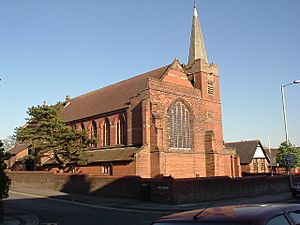Christ Church, Wesham facts for kids
Quick facts for kids Christ Church |
|
|---|---|

Christ Church from Garstang Road North
|
|
| Lua error in Module:Location_map at line 420: attempt to index field 'wikibase' (a nil value). | |
| OS grid reference | SD 41762 33024 |
| Location | Wesham, Lancashire |
| Country | England |
| Denomination | Anglican |
| History | |
| Status | Parish church |
| Founded | 1893–94 |
| Architecture | |
| Functional status | Active |
| Heritage designation | Grade II |
| Designated | 11 June 1986 |
| Architect(s) | Austin, Paley and Austin Austin and Paley |
| Architectural type | Decorated Perpendicular |
| Construction cost | £3,350 (equivalent to £270,000 in 2021) |
| Administration | |
| Deanery | Kirkham |
| Archdeaconry | Lancaster |
| Diocese | Blackburn |
| Province | York |
Christ Church is a beautiful Anglican church located in Wesham, a small town in Lancashire, England. It is an active parish church, which means it serves the local community. The church is part of the Diocese of Blackburn.
Built in the late 1800s, Christ Church is recognized as a special and important building. It is listed as a Grade II listed building, which helps protect its unique history and design for future generations to enjoy.
Contents
The Story of Christ Church
The church was built by a team of famous architects from Lancaster named Paley, Austin and Paley. The work began in 1893, but it was built in two main stages.
Building the Church
The first part of the church was finished in 1894. It had enough seats for 229 people and cost £3,350. That may not sound like much today, but back then it was a huge amount of money! The foundation stone was officially laid on June 30, 1892, and the church was opened on September 27, 1894.
About 30 years later, between 1927 and 1928, the church was made bigger. The east end of the church was finally added, along with a new porch. More seats were put in, so the church could then hold 317 people. This second stage of building was led by Henry Paley, one of the original architects, and cost £5,650.
For many years, Christ Church was a "chapel-of-ease," helping the main church in the nearby town of Kirkham. In 1913, it became its own separate parish.
The Church in Modern Times
Christ Church is still a very active place. In 2013, the famous singer Graham Kendrick held a concert there.
Between 2017 and 2024, the vicar was Rev Anne Beverley. In 2021, during the COVID-19 lockdown, she made a TikTok video for a few local teenagers. To her surprise, the video went viral and was watched by 1.7 million people all over the world!
In June 2025, it was announced that Jono Peatman would be the new vicar for the church.
What Does the Church Look Like?
Christ Church was built in a style that mixes two historical designs: Decorated and Perpendicular. This gives it a grand and elegant look with lots of detail.
Outside Design
The church is made of red brick, with special decorations made from red terracotta, a type of baked clay. The roof is covered with red tiles.
One of the most noticeable features is the steeple, which is a tower with a pointed top. The tower is built in three sections and has a stone parapet (a low wall) at the top. The pointed part of the steeple is covered in green slate, a type of rock.
Inside the Church
The main part of the church is a long hall, which includes the nave (where the people sit) and the chancel (the area near the altar). The nave is divided into six sections, or bays, by stone pillars called piers.
At the east end of the chancel, there is a very large window. It has beautiful and complex stone patterns called tracery, which is a key feature of the Decorated style.
Outside the Church Walls
In the churchyard, you can find the war graves of several soldiers. These graves honor two soldiers from World War I and five servicemen from World War II. They are cared for by a special organization that makes sure we never forget their sacrifice.
There is also a memorial stone for the paupers of the Wesham Workhouse. A workhouse was a place where very poor people lived and worked. This memorial helps us remember a difficult part of the area's history.
Gallery
See also
- Listed buildings in Medlar-with-Wesham
- List of works by Paley, Austin and Paley
- List of ecclesiastical works by Austin and Paley (1916–44)



